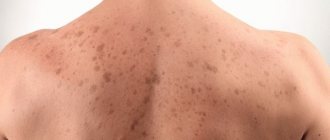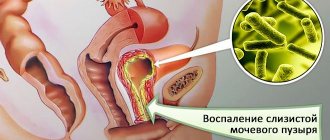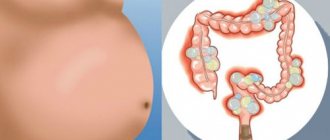Herpes on the lips is perhaps the most common manifestation of herpetic rashes. Most people believe that cold rashes in the lip area are only a cosmetic problem, and are only afraid of subsequently getting scars or a scar in the area of the lesions. But a herpetic rash can indicate serious disorders of the body. Below we will look at where herpes comes from and what herpes actually is, how it can begin, its variety, and different localization in the lip area.
General information
The vast majority of people have repeatedly encountered the phenomenon of “cold lips”, however, not everyone knows what such a “cold on the lips” is called.
In most cases, the appearance of rashes and blisters on the lips is a manifestation of a herpes infection (herpes). Herpes lips (oral herpes) is a recurrent herpetic infection characterized by single/grouped vesicular rashes with a diameter of 1-3 mm on the mucous membrane, red border of the lips and adjacent areas of the skin, located on an edematous-erythematous base. Caused by herpes simplex viruses (HSV), a labial form of herpes simplex type 1 antigen. Sometimes in everyday vocabulary, herpetic rashes on the lips are called “malaria on the lips.” Often patients complain that a sore has appeared on the lip, but not herpes. Of course, similar clinical manifestations can occur in other diseases, for example, with cheilitis of various etiologies, angulitis (snagging in the corners of the lips), allergies , dermatitis , fungal infections, etc., but in most cases this is what the herpes virus on the lips looks like.
What does herpes on the lips look like?
The figure below shows what herpes on the lips looks like depending on the location (outside/inside the lip).
Herpes on the outside of the lip, herpes on the inside of the lip, herpes in the corners of the lips
The herpes simplex virus is widespread. Infection with herpes simplex in the general population is about 75% and about half of them suffer several attacks of the virus. At the same time, there is a tendency towards an increase in the incidence of herpes infection, which is largely facilitated by the spread of immunodeficiency (immunosuppressive) conditions.
Despite the availability of fairly extensive information about herpes virus infection, many do not understand why herpes on the lips is dangerous. Therefore, we repeat once again that herpes on the lips is extremely dangerous due to:
- Highly contagious.
- The risk of involvement of various organs in the infectious process through mechanical transfer of the pathogen (autoinoculation) from the herpetic lesion in the lip area to other places, for example, on the conjunctiva of the eye, in the oral cavity, on the mucous membrane of the genital organs, as well as through microdamage to the skin on any part of the body ( herpetic stomatitis , herpetic sore throat , ophthalmoherpes , etc.).
- The risk of secondary microflora joining with the formation of superficial scars on the lips after the rash resolves.
Pathogenesis
The herpes simplex virus, after initial contact with the source of infection, enters the epithelium of the skin/mucosal membrane and, by fusion of the cell membrane with the outer shell of the virus, migrates into nerve cells, where herpes DNA is released. Further, along the dendrites of the nerve endings, the DNA of the herpes virus is transported into the body of the sensitive neuron of the sensory ganglion and is forever integrated into its genetic apparatus, where it remains in a latent state.
Then, under the influence of unfavorable factors or a deficiency of immunity in the body, the activation of the virus begins - the process of persistence (active reproduction in the cell). With herpetic lesions of the epithelium of the mucous membrane of the lips and the red border, persistence of the virus occurs in the sensitive neurocytes of the trigeminal ganglia. The process of persistence and release of the virus immediately after infection occurs practically asymptomatically. The duration of this intensive breeding period (before the first clinical signs appear) takes 7-10 days. During this period, focal death of the epithelium occurs, forming foci of dead cells.
In the area of the affected cells, a focus of inflammation is formed, which is clinically manifested by the appearance of characteristic single/grouped vesicles on the mucous membrane/skin of the lip. As they multiply, new virions (viremia), which predominantly circulate as part of the formed blood elements (erythrocytes, platelets and lymphocytes). In this case, damage to chromosomes and accumulations of HSV antigen are observed in leukocytes. Replication of the virus occurs in the nuclei of neurons and along the efferent nerve fibers the herpes virus can again reach the mucous membranes/skin and spread with the appearance of new rashes.
In a normal state of immunity, the virus is eliminated from organs and tissues and remains throughout life only in the neurons of the sensory ganglia. That is, virus reproduction is controlled directly by immune mechanisms. When immunity is weakened, especially with defects in the T-cell component, macrophages, and interferon , activation and reproduction of the virus begins. As immunosuppression increases, the frequency of viral activation increases, new ganglia are involved in the process of viral replication, which increases the prevalence of lesions. The figure below shows the stages of pathogenesis.
Features of the life of the virus
The herpes virus invades the mucous membranes, vigorously moves towards the nerve endings, and integrates into the DNA of the nerve cell so that it begins to produce it itself.
Hidden in neurons, Herpes simplex virus becomes inaccessible to the immune system and lives there in a latent form, without causing discomfort to the host until activation, since viral particles that have gone beyond the boundaries of neurons are immediately destroyed by immune forces. However, with a decrease in immunity or other provoking circumstances, they are activated, invade other tissues, and infect the body.
The peculiarity of the herpes virus being undetected for the time being, hiding in the nerve ganglia, creates a persistent, sometimes unexpected danger of relapse.
It is impossible to derive it from DNA. Once in the body, it remains there for life!
Classification
Based on the mechanism of infection, a distinction is made between primary and recurrent ortholabiltic herpes . According to clinical manifestation and area of damage:
- Limited damage - single vesicles on the surface of the lips.
- Multiple lesions - multiple vesicles on the lips, which can merge and involve the red border of the lips.
- Extensive damage - vesicles extend beyond the lips, the process involves the skin of the perioral area, nasolabial triangle, and less often - the skin on the cheeks.
Causes of herpes on the lips
The causative agent of herpes (the cause of a “cold on the lip”) is the herpes simplex virus.
Morphology
HSV is a typical representative of DNA viruses. The size of the virus varies between 150–300 nm. In addition to DNA, its structure includes an icosahedral capsid containing 162 capsomeres and an outer protein-lipid shell. Through the glycoproteins of the virus, the mechanism of attachment of the viral particle and its penetration into the cell with the formation of virus-neutralizing antibodies is realized (Fig. below).
The virus reproduces intracellularly (in the nucleus/cytoplasm), and the average duration of the reproduction cycle is about 10 hours.
There are 2 types of HSV - HSV-1 and HSV-2. Representatives of these types of virus, despite certain differences, have a common group-specific nucleocapsid antigen, however, there are differences in type-specific antigens, which determines certain differences in pathogenicity and virulence. In this case, HSV-1 causes damage mainly to the nasolabial region, and HSV-2 causes genital herpes and generalized forms. At the same time, modern data indicate an increasing role of HSV-1 in the development of genital herpes, reaching 50% according to some data. There has also been an increase in the incidence of herpes labialis , which is caused by HSV-2.
With the development of the infectious process, daughter virions are released from the collapsing cells, and the tissue tropism inherent in the herpes virus and its ability to persist (the ability to continuously reproduce) and latency (is in a latent state in the body) provides a high ability to develop/maintain the infectious process.
HSV in conditions of normal humidity and room temperature persists throughout the day. It is inactivated after 30-40 minutes when heated to 50-52°C; at low temperatures, viability remains for five days; on a damp surface - during its drying time (up to 6 hours). Extremely unstable to physical/chemical factors: disinfectants, organic solvents, proteolytic enzymes, ultraviolet irradiation.
Epidemiology. How is herpes on the lips transmitted?
Herpes (cold on the lip) appears due to infection with a virus, which in most cases occurs through direct contact with the patient (the presence of the virus in secretions and biological fluids) or through household and hygiene items contaminated with the virus (handkerchiefs, towels, dishes, etc.) .d.). The virus is also transmitted by airborne droplets. The source of infection can be both patients with herpes and virus carriers who do not have symptoms of herpes, which answers the question that interests many: is it possible to kiss if a partner has a herpes infection and is the patient/virus carrier infectious to others. In an infected person (depending on the location), herpes viruses are present in various biological material (secretions) - nasopharyngeal mucus, vesicle contents, tear fluid, menstrual blood, erosions/vesicles/ulcers, amniotic fluid, vaginal/cervical secretions, sperm. With viremia, HSV circulates in the blood and is also excreted in the urine.
The maximum concentration of the virus in biological material is observed in manifest forms of herpes virus infection and in lower concentrations in asymptomatic cases and virus carriers, which explains why herpes on the lips often appears through direct contact even with an apparently healthy person.
The occurrence of herpes on the lips (exacerbation of recurrent herpes in persons infected with HSV) is provoked by predisposing factors that contribute to the activation of the viral infection, such as:
- Excessive solar insolation.
- Exacerbations of chronic infection/acute infections.
- Hypothermia/freezing.
- Physical/mental trauma.
- Drinking alcohol.
- Injury/damage to the mucous membrane and skin of the lips.
- Dental manipulations.
- Hormonal changes.
Factors contributing to the recurrence of herpes infection include deviations in the cellular/humoral immunity, a decrease in the level of immunoglobulins, the development of immunosuppressive conditions, and the use of immunosuppressants.
The intensity/frequency of exacerbations of recurrent herpes simplex depends on the pathogenicity and virulence of the pathogen, as well as on the state of the person’s immunity. When the virus is localized on the lips, the duration of viral shedding of herpes simplex type 1 varies between 6-30 days. After infection, the body begins to synthesize antibodies against a specific type of herpes virus, which helps stop the development of the infectious process.
Despite the fact that the herpes virus, its pathogenesis, causes and clinic are well studied, there are alternative theories that believe that the herpes virus is a psychosomatic disease, and the cause of frequent herpes on the lips lies in an incorrect perception of the world around us and an incorrect reaction to events in it , manifested by condemnation of people, expressed anger, pathological greed, or perceived as punishment, for example, for adultery, extramarital sex life, etc. Thus, herpes psychosomatics refers to a condition that arises at a time when a person experiences a strong psychological conflict between desire and a ban on it (dual contradictory emotions), a feeling of guilt. Of course, there is no scientific basis for such theories and how to treat them, whether to believe in them or not, everyone decides for themselves.
Symptoms of herpes on the lips
With the typical localization of simple recurrent herpes on the lips, the skin/mucous membrane is predominantly affected, especially the corners and red border of the lips; less often, the skin around the mouth and wings of the nose are involved in the process. The incubation period of herpes infection - the period of contagiousness is usually 6-7 days, but can vary between 1-26 days.
How does herpes on the lips begin?
As a rule, when herpes recurs 1-2 days before the first clinical manifestations, in most people the disease begins with subjective prodromal manifestations in the form of burning, itching, pain, tingling and discomfort on the lips. With compromised immunity, in the first days there may be signs of general intoxication: malaise, fever, joint/muscle pain and headaches, which in some cases may appear at the initial stage simultaneously with rashes.
In typical cases, the initial stage is characterized by the appearance of a rash in the form of vesicles filled with light serous fluid. The picture below shows herpes on the lips (photo of the initial stage).
Often, bubbles (vesicles) appear against a background of limited edematous erythema of varying intensity. The number of vesicles can vary from single elements with a diameter of 1-3 mm to several dozen, which can be grouped. Sometimes they merge to form tense, flat, multi-chambered blisters (picture below).
After a few days, the serous contents of the blisters become cloudy, the blisters open and form erosions with uneven outlines, in place of which, after 3-5 days, loose honey-yellow crusts form, which soon disappear, and epithelization occurs.
Less commonly, as already mentioned, herpes on the lips occurs with the involvement of the skin of the perioral zone and/or nasolabial triangle.
Many people are interested in the question “how long does it take for herpes on the lip to go away”? On average, with a typical course of herpes, the process takes place in 8-10 days, but in cases of weakened immunity, the process can take up to 2-2.5 weeks. The figure below shows the duration of each stage of herpes and the process as a whole.
Development of the herpes virus over time
In cases of infection of erosion by secondary microflora, it can transform into a superficial ulcer with a compacted bottom and slight swelling along the periphery. regional lymphadenitis may develop , in which the lymph nodes on palpation are moderately painful and have a doughy consistency.
Herpes and weakened immunity
During primary infection, IgM antibodies are formed, and during relapses, IgG and IgA are formed. Due to the persistence of the virus in infected people, the immunity is non-sterile. In some periods, under the influence of various factors, the disease may worsen and manifest itself in the form of well-known symptoms. In addition, the herpes virus itself is capable of inducing immunodeficiency. The level of immunity significantly affects the number and severity of relapses. After the active infection stage, the virus remains in an inactive state to live in the sensory ganglia and ganglia of the autonomic nervous system. No viral particles are produced in this phase. The frequency and severity of outbreaks varies widely among individuals. Some people develop ulcers that do not heal for weeks, while others experience only minor itching and burning for a few days. There is some evidence that heredity influences relapse rates. In the region of chromosome 21, there is a zone that includes 6 genes, which is associated with the frequency of outbreaks. The severity of outbreaks and their frequency decreases over time. After a few years, some people will have no symptoms at all, although the virus will still be shed and able to spread to others. In people with defective immune systems, outbreaks will be more severe, longer, and more frequent. Outbreaks may occur in previous locations or in close proximity to the nerve endings of infected ganglia.
Tests and diagnostics
The diagnosis of herpes on the lip is established on the basis of a characteristic clinical picture (the presence of external manifestations). If it is necessary to identify the type of herpes virus or in the early stages of the disease, when there are still no clear symptoms to make a diagnosis, a cytological examination of a biopsy (the contents of herpetic vesicles) can be used, in which giant multinucleated cells with intranuclear inclusions of the virus and antigen are found in the smears.
Differentiation of HSV or HSV serotypes from other viruses of the herpes family can be done by immune electron microscopy. Among the methods for serological identification of the virus, if necessary, the complement fixation reaction is used.
Traditional treatment
In cases where there are no suitable pharmaceuticals at home, alternative medicine can also be used to treat labial herpes. Thus, traditional healers recommend treating a rash that has already appeared every 2 hours with one of the following compositions:
- sea buckthorn, fir or almond oil;
- liquid pine resin;
- a solution of table salt or soda - 5 pinches per 100 ml of water;
- decoction of white wormwood - a tablespoon of raw material per glass of water, cook for 10 minutes;
- mint toothpaste;
- citric acid solution (7 pinches per 100 ml of water) or freshly squeezed lemon juice;
- alcohol tincture of propolis;
- fresh celandine juice;
- earwax;
- Kalanchoe or aloe juice;
- sage infusion - 2 tablespoons per glass of water, leave for 40 minutes;
- thick bee honey;
- garlic juice, half diluted with warm water;
- baby powders;
- decoction of aspen leaves - 3 tablespoons per glass of water, cook for 15 minutes;
- strong brewed black tea - 2 tablespoons of tea leaves per ¾ cup of water.
At the first signs of illness, you can treat your lips with Valocordin or Corvalol. In some cases, this helps prevent the appearance of a rash and significantly alleviate the symptoms of the pathological process.
Folk remedies for colds on the lips
Treatment of herpes on the lips with folk remedies, as evidenced by numerous reviews, allows you to get rid of malaria on the lips in the initial stages of the development of the disease. According to many patients, colds on the lips can be quickly treated using such remedies as:
- Toothpaste. Its action is explained by its constituents menthol, fluorine, zinc and alcohol, which dry out the bubbles well. For this purpose, it is necessary to use a paste with fluorine, zinc, menthol or containing natural ingredients (oak bark, chamomile, eucalyptus). The paste is applied 3-4 times a day to the affected area of the lips in a thin layer for 10-15 minutes, after which it is washed off.
- Heart medications ( Corvalol / Valocordin ). According to many, this is the best remedy for colds on the lips. To do this, it is enough to cauterize the herpes blisters with this drug 3-4 times a day.
- Aloe juice , eucalyptus , propolis tincture, calendula flowers, chamomile, pine buds, warty birch (leaves, buds, juice), sage leaves, tea tree oil. Apply to rashes every two hours. These folk remedies have anti-inflammatory, epithelializing and antiviral effects.
Many women, when herpes appears on the lip, try to hide the rash by using decorative cosmetics for this purpose. However, this is far from the best option, since a thick layer of cosmetics slows down the healing process. In addition, there is a risk of triggering the opening of the vesicles, and then, in the process of applying makeup, increasing the affected area, spreading the herpes virus throughout the face.
How to disguise lip rashes in a relatively safe way? For this purpose, it is recommended to use an antiherpetic patch, which also has a therapeutic effect. Before gluing it, the skin must be disinfected and dried, then applied to the affected area, changing 2-3 times a day. It is also important to know which doctor treats herpes on the lips. As a rule, this is a dermatologist, and in complicated cases, consultation with an infectious disease specialist may be necessary.
Medicines against herpes: what to choose?
The best medicine for a cold on the lip is the one that most effectively fights the virus: Modern pharmacies offer various names of drugs to combat herpes. It is difficult for an inexperienced layman to make the right choice and evaluate the effectiveness of the proposed means. Therefore, the choice of drug is often determined by its cost. Let's figure out how the proposed medications differ. What drug can you choose and what should you do if a cold appears on your lip?
Acyclovir: the pioneer of herpes treatment
The most affordable antiviral drugs for the treatment of herpes on the lips with the active ingredient “ acyclovir”
"
The synthesis of this substance revolutionized the treatment of herpetic infections in the 80s of the last century. Based on it, two dozen trade names of antiviral drugs were developed.
The effect of acyclovir is to stop the spread of herpes within the body. Drugs containing acyclovir are characterized by low toxicity, rarely cause adverse reactions and are approved for treatment during pregnancy, and are widely used in pediatrics.
The number of drugs that contain acyclovir is more than two dozen items. Here are some of the most famous: Zovirax, Atsik, Gerpevir, Virolex, Ciclovir, Acyclovir-Acri, Geviran, Gerpetad, Medovir, Valmax
. They all contain the same active ingredient and therefore are characterized by the same effectiveness.
Various acyclovir ointments for cold sores on the lips have the same therapeutic effect, so you can choose the most affordable ointment among them for a cold on the lip.
Due to the mutation of the virus, today acyclovir has lost 100% effectiveness against all types of herpes viruses. The best treatment results are obtained the first time the drug is used with acyclovir. In the future, with possible relapses, the effectiveness of treatment decreases.
Acyclovir is often the #1 choice in the question “when there is a cold on the lip, what should you do?” This is the most affordable and most common antiviral agent in treatment.
Generic acyclovir: valacyclovir, penciclovir, famvir
Generic acyclovir provides a more effective effect on the virus and is also used in a number of commercial drugs. In the human body, generics are processed into acyclovir or similar substances (penciclovir) and ensure a constant concentration of the drug component in the blood.
Remedies for herpes on the lip based on generics of acyclovir:
- Valacyclovir and Valtrex (synthesized into acyclovir);
- Penciclovir and Famvir (synthesized into penciclovir).
Famvir is a tablet medicine for herpes on the lip. It is not available in ointment or injection form. This highly effective remedy is taken orally. The drug is taken in two or three doses during the first day of the disease. The total amount of medication for an adult is 1500 mg per day. The product is not used for children due to the lack of long-term studies of the drug and its possible toxicity.
Panavir
Panavir is an antiviral drug of plant origin. It is made from the extract of nightshade plants (potatoes). When deciding how to quickly cure herpes on the lip, you can stop at this drug.
Panavir not only stops the vital activity of the virus, but also stimulates a person’s own immunity. It is characterized by high efficiency, low toxicity, and a broad antiviral effect (not only against herpes, but also against arthritis, encephalitis, cytomegalovirus, papilloma, as well as influenza and ARVI).
Panavir is available in various forms:
- injection;
- rectal suppositories (quickly absorbed into the blood and do not irritate the gastric mucosa);
- vaginal suppositories;
- spray;
- gel.
Note Not for use in the treatment of children and pregnant women.
What helps better against herpes on the lips - tablets, injections, suppositories or ointments - depends on the individual characteristics of the patient. For a minor rash, you can get by with local treatment (gel or spray). For large wounds and general intoxication, fever, it is necessary to take medications orally (tablets, injections, rectal suppositories).
Herpes on the lip of a child
The greatest danger is posed by primary herpes on the lip of a child. The form of primary herpes is most common in children from six months to 3 years of age, which is due to the disappearance of maternal antibodies by the age of six months, as well as insufficient development of the immune system.
A cold on the lip in a child (1-2 years old) can also be a consequence of frequent trauma (violation of the integrity of the mucous membrane of the lips caused by teething). In addition, the appearance of herpes in infants is often caused by the presence of the herpes virus on the lip of a nursing mother. In this case, the most common are herpetic skin lesions, manifested by typical diffuse blistering rashes on the face and torso; ophthalmic herpes and herpetic stomatitis are less common. Treatment of herpes on the lips in children is carried out similarly to adult patients, taking into account age-related doses when prescribing medications.
Immunostimulants against herpes
Immunostimulants do not act directly on the herpes virus. They increase the resistance of body cells to viral effects and thereby prevent the spread of the awakened virus and the appearance of external symptoms.
- Immunoglobulin - used for severe forms of herpes infection (in newborns and in pregnant women with primary herpes during pregnancy). A type of drug - Sandoglobulin - contains an increased amount of antiherpetic antibodies.
- Interferon - prevents viral infection of cells. Interferon-based drugs are used in the treatment of children and adults. They provide broad antiviral, antibacterial and anti-inflammatory effects.
Preparations with interferon are available in various forms:
- rectal suppositories (Viferon, Genferon, Kipferon);
- tablets (Amiksin, Arbidol, Apizarin, Flocazid);
- ointments (Viferon-ointment, Infagel);
- powders or solutions for injection (Interferon, Alfaferon, Altevir, Interal, Intron, Roferon, PegItron, Realdiron).
The course of treatment with interferon drugs is 5 days; to prevent relapses, repeated courses are recommended after 2-3 weeks.
- Cycloferon is a broad-spectrum antiviral agent that acts against a number of viruses (herpes, hepatitis, influenza strains). The drug reduces the viability of viral progeny and increases the body's resistance to viral and bacterial infections.
The drug is available in the form of tablets and ointments. The dose of medication is determined by age. The required number of tablets is taken once a day, the course of treatment is 20-30 days.
Groprinosin is a dual-action agent that strengthens the immune system and suppresses the virus.
Herpes on the lips during pregnancy
Herpetic rashes on the lips are a fairly common occurrence during pregnancy, which is due to the suppression of a woman’s immunity during this period - natural immunosuppression in the mother’s body in order to avoid the risk of rejection of a fetus that is not genetically identical to her body.
Is orolatable herpes on the lips dangerous for the health of the unborn child? Unlike genital herpes, which poses a serious threat to the course of pregnancy, the fetus and newborn child, a cold on the lip during pregnancy in most cases is not a direct threat to the fetus, since the placental barrier can only be overcome by a virus circulating in the blood (viremia), and not located on lip That is, if herpes occurs in a local form without viremia, the threat is minimal.
The risk to the fetus exists only in the case of mechanical transfer of HSV-1 from the lip area to the mucous membrane of the genital organs, which creates the possibility of developing genital herpes under the influence of HSV-1 or in the form of a mixed infection of HSV-1 and type 2. The results of recent studies indicate that HSV-1 with genital herpes is detected in 15-25% of cases. In this case, herpes on the lip during pregnancy (1st trimester), when entering the systemic bloodstream, increases the risk of spontaneous abortion and death of the embryo and the formation of systemic pathology, since the 1st trimester is the period of formation of organs and body systems, and herpes on the lip during pregnancy (2nd trimester ) is accompanied by the risk of developing early fetopathy and spontaneous abortion in the 2nd trimester.
The risk also increases in cases of primary infection with herpes simplex virus type 1 during pregnancy, especially in cases of immunodeficiency, however, such cases are extremely rare, since in 90% of cases primary infection occurs in childhood and at the time of pregnancy antibodies are already present in the woman’s blood to the herpes virus. To find out whether this is a primary herpes infection or not, you need to donate blood for the presence of IgG and IgM antibodies to HSV (PCR test for the presence of HSV DNA in the blood), since the absence of rashes on the lips in the past does not mean that you have not previously been infected with the virus.
What triggers the activation of infection?
Before external symptoms appear, few people know about the presence of infection, since antibodies suppress the activity of vibrio. But with provoking factors and decreased immunity, the disease “shoots up.”
Having received an impetus for activation, Herpes simplex virus of the first type rushes along the nerve canals to “weak” places, is most often localized on the nasolabial triangle, and is expressed by external symptoms. This arrangement is also justified by the fact that these places are connected by the trigeminal plexus of nerves. Damage to the conjunctiva and cornea of the eyes is also possible.
Other types of herpes infection manifest themselves in their own ways.
For example (Herpes zoster), herpes zoster, the symptoms of which are manifested by herpetic rashes on the body, accompanied by severe pain, appears most often in older adults. It is treated with antiviral and painkillers. The disease is characterized by severe complications and persistent residual effects.
You should understand!
- It is not possible to defeat the herpes virus.
- If you once have a manifestation of the virus, then your body is infected for life.
- The fight is to relieve symptoms, prevent relapses of exacerbation, and increase the body’s immune strength.
How to treat herpes on the lips during pregnancy?
First of all, it should be said that drug prophylaxis is not carried out during pregnancy. This should be done while preparing for pregnancy. Treatment in pregnant women comes down to local therapy, for which you can use Zovirax cream and other medications for local therapy listed above without restrictions. Herpebin may be prescribed to reduce the risk of viremia .
Diet
Diet for herpes
- Efficacy: therapeutic effect after a week
- Duration: a month or more
- Cost of products: 1400-1500 rubles per week
The diet for lip herpes includes a balanced diet. To strengthen the immune system, you should include in your diet a sufficient amount of foods containing microelements and vitamins (vegetables, lean meat, fish, whole grain cereals, fruits) and always fermented milk products with bifidobacteria , which normalizes the intestinal microflora and improves immunity.
To reduce the risk of relapse, it is recommended to limit the consumption of alcohol, sugar and sugar-containing products, as well as products containing argenine (muesli, wheat flour, peanuts, chocolate, raisins, refined pasta, seeds), as well as increase the consumption of products containing lysine , which prevents the reproduction of the herpes virus, lengthens the period of remission, prevents relapses (dairy products, including cottage cheese and soft cheeses, chicken eggs, peas, soybeans, beans, chicken, rabbit, herring, sardine, cod). It is also recommended to take additional vitamin-mineral complexes and a sufficient amount of liquid, especially rosehip decoction, freshly squeezed juices, fruit drinks, compotes and herbal teas.
Prevention of herpes on the lips
Primary prevention of ortholatable herpes caused by HSV-1 is aimed at preventing infection/minimizing relapses and includes:
- Limiting contact with people who have clinical herpes on the lips due to the high contagiousness of the disease.
- Compliance with household prevention/sanitation measures: use individual utensils and hygiene products (towels, face cream, lipstick).
- Minimizing the impact of factors that cause reactivation of the herpes simplex virus (ultraviolet radiation, hypothermia, alcohol abuse, trauma to the skin of the lips, psycho-emotional stress, sudden climate change, etc.).
- Strengthening the immune system (hardening, balanced nutrition, taking adaptogens, vitamin-mineral complexes and herbal remedies that strengthen the immune system).
- If there are vesicles on the lips, in order to limit the risk of spreading the virus to other areas of the skin, mucous membranes and other parts of the body (organs), you should not touch with your hands, comb, rub, crush herpes blisters, or tear off the scabs until complete epithelialization. In case of contact with them, wash your hands thoroughly or use chlorhexidine / miramistin to sanitize your lips.
Secondary prevention of relapses of herpes labialis involves immunostimulating therapy and vaccination with an inactivated herpes vaccine. The use of the vaccine helps stimulate the mechanism of antiviral immunity, which is due to the restoration of the functional activity of immunocompetent cellular elements and specific desensitization of the body. In general, the implementation of such a set of measures allows both to prevent the appearance of herpes on the lips and to minimize the risk of its spread.
Preventive measures
Based on information about how herpes appears, it is not difficult to understand what needs to be done to reduce the risk of contracting it. It is almost impossible to isolate yourself from infection, since carriers of the virus can transmit it. However, they may not have any signs of the disease. It is impossible to isolate yourself from communication with others, which is why you need to take care to prevent a recurrence of unpleasant consequences.
The first infection with HSV should be treated like a vaccination. When faced with it, the body produces special antibodies that help strengthen the immune system. This system makes it possible to prevent a second infection during life.
To avoid relapse, you must adhere to the following measures:
- Active lifestyle (physical exercise, walking outdoors).
- Balanced diet, healthy fortified foods.
- Hardening the body.
- During the treatment of colds and infectious diseases.
- Do not stay in the sun for a long time.
- Avoid overwork.
- Be less nervous.
The temperature regime should not be neglected. Too high or low temperature has a negative effect on the body. You need to carefully monitor and take care of it, then the simple herpes virus will not have the opportunity to activate. If these preventive measures do not have an effect and the disease appears too often, it is necessary to consult an immunologist who will help identify the cause of the relapse.
Consequences and complications
Complex treatment of herpes infection on the lips caused by herpes simplex virus type 1 allows the process to be stopped in a short time and lead to stable remission. At the same time, its course can be complicated by the involvement of various organs in the process by mechanical transfer of the pathogen from the herpetic focus in the lip area to other places - to the conjunctiva of the eye, to the oral cavity, to the mucous membrane of the genital organs and other parts of the body ( ophthalmoherpes , herpetic stomatitis , genital herpes and etc.). Also, there is a risk of the addition of secondary microflora, which may result in the formation of superficial scars on the lips after the rash resolves.
What is the danger of the herpes simplex virus?
Herpes often appears: is it so harmless?
- This form of infection is contagious and is easily transmitted through contact with the mucous membrane of a patient if there are wounds or microcracks on the mucous membrane or body.
- The consequences after infection can be dangerous. There is a risk of damage to organ tissue.
- Herpes infection can cause complications on the body in the first three months of pregnancy. There are high chances of disrupting the child’s brain function or even losing it.
- The herpes simplex virus is a clear indicator of weak immunity, which increases the risk of developing chronic diseases.
List of sources
- Chigvintseva E.A., Gerasimova N.M. Modern problems of epidemiology, diagnosis and treatment of herpes viral diseases // Modern problems of dermatovenerology, immunology and medical cosmetology. – 2009. – No. 3. – P. 89-94.
- Tishchenko M.S., Serebryakov M.Yu., Voronov A.V., Serebryakov D.Yu. Treatment of patients with herpes infection. Anniversary collection of articles from RGMU, dedicated to the 100th anniversary of RGMU. – 2006. – P. 1-7.
- Isakov V.A. Human herpesvirus infections: a guide for doctors / V.A. Isakov, E.I. Arkhipova, D.V. Isakov – St. Petersburg: SpetsLit, 2013. – 670 p.
- Kazmirchuk V.E. Clinic, diagnosis and treatment of human herpesvirus infections: monograph / V.E. Kazmirchuk, D.V. Maltsev – K.: Phoenix, 2009 – 248 p.
- Kalinina N.M., Davydova N.I. The role of immunotropic therapy in increasing the effectiveness of treatment of herpes viral infections // Terra Medica. – 2009. – No. 1(56). – P.17-22.










